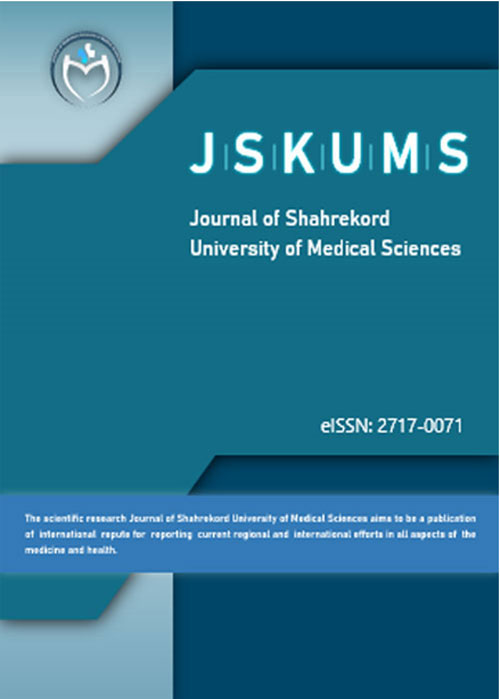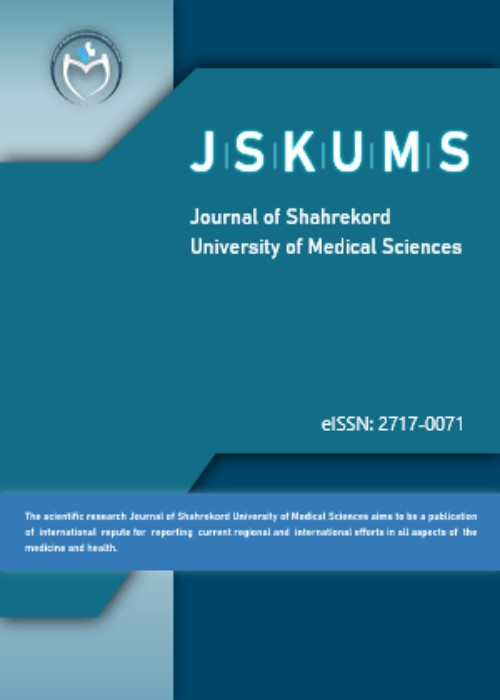فهرست مطالب

مجله دانشگاه علوم پزشکی شهرکرد
سال بیست و چهارم شماره 3 (پیاپی 116، Summer 2022)
- تاریخ انتشار: 1401/05/29
- تعداد عناوین: 8
-
-
Pages 104-110Background and aims
The lack of effective antiviral drugs for adenoviruses is one of the most important problems in this area. The aim of this study was to investigate the phytochemical properties and antiviral effect of the green tea extract (GTE) on adenovirus in HEp2 cells in vitro.
MethodsIn this experimental study, dried leaves of green tea were extracted by maceration. Total phenolic content (TPC), total flavonoid content (TFC), and antioxidant capacity of the extract were measured by Folin-Ciocalteu, aluminum chloride, and 2,2-diphenyl-1- picrylhydrazyl (DPPH) colorimetric methods, respectively. The amounts of some phenolic compounds in the extract were also determined using high-performance liquid chromatography. The toxicity of the extract on Hep2 cells and antiviral activity of the extract on adenovirus were assessed by the MTT colorimetric method. The half-maximum cytotoxicity concentration (CC50) and the 50% inhibitory concentration (IC50) of the extract were calculated as well.
ResultsPhytochemical investigations showed that the IC50 of DPPH radical was 42.1 ± 3.2 μg/mL compared with butylated hydroxytoluene (IC50 of 33.5 ± 3.67 μg/mL). The TPC and TFC of the extract were 74.2 mg GAE/g and 16.3 mg RE/g of the dry extract, respectively. The extract demonstrated the highest amounts of syringic acid, gallic acid, 3,4-dihydroxybenzoic acid, and rutin levels (67.27, 20.12, 7.39, and 2.97 mg/g DW, respectively). Based on the results of cell culture, the CC50 and IC50 of GTE were 103.3 μg/mL and 25.16 μg/mL, respectively.
ConclusionGTE with phenolic and flavonoid compounds can exert dose-dependent inhibitory effects on adenoviruses.
Keywords: Adenovirus, Camellia sinensis, Antiviral effect, Green tea -
Pages 111-116Background and aims
This study was conducted to compare the effects of two compounds ropivacaine and lidocaine associated with epinephrine on the heart rate, blood pressure, and bleeding rate in children undergoing general anesthesia for the cleft palate repair surgery.
MethodsIn this study, 30 children candidates for cleft palate surgery who were referred to Mofid Children’s Hospital, affiliated with Shahid Beheshti University of Medical Sciences in 2021, were included by using the convenience sampling method. The patients were randomly divided into two groups. Group 1 was treated with ropivacaine and group 2 was treated with lidocaine along with epinephrine. The data were analyzed by the SPSS, version 22.
ResultsIn total, no statistically significant difference was found between the two groups in terms of vital signs of blood pressure and heart rate in the 10 stages studied (P<0.05). There was no difference between the two groups in the trend of the changes in blood pressure (P=0.381) and heart rate (P=0.940). However, the trend of blood pressure and heart rate had significantly changed during the study in both groups individually (P<0.001). The bleeding rate (suction) (P<0.001) and the weight of gases used (P=0.003) in the second group were significantly higher than in the first group.
ConclusionNo difference was found between the effects of ropivacaine and lidocaine combined with epinephrine on the heart rate and blood pressure in patients who were candidates for the cleft palate surgery, but the rate of bleeding (suction) in the second group was more than the first group.
Keywords: Ropivacaine, Lidocaine, Epinephrine, Cleft palate, Heart rate, Blood pressure -
Pages 117-121Background and aims
Acute respiratory distress syndrome (ARDS) treatment is supportive, and there is no currently approved treatment for it. This study, therefore, aimed to investigate the effect of endotracheal administration of N-acetyl cysteine (NAC) and heparin on the level of secretion and partial thromboplastin time (PTT) in ARDS patients under mechanical ventilation.
MethodsIn this clinical trial study, 70 patients aged over 18 years (30 women and 40 men) admitted to the intensive care unit were randomly selected following the allocation rule and then divided into two groups (intervention and control). In addition to the routine and available treatments in the ward given to the patients in both groups, the control group also received 10 mL of normal saline every six hours through the endotracheal route, while the intervention group received 500 units of heparin plus 200 mg of NAC dissolved in 10 mL of normal saline every six hours through the same administration route.
ResultsThe mean and standard deviation levels of PTT in the control and intervention groups were 30.3743 ± 7.78008 and 32.2286 ± 8.31047, respectively, with no significant difference (P>0.05); the volume of secretion on days 1-3 was not significantly different between the two groups, but the difference was statistically significant from day 4 onwards (P<0.05).
ConclusionTaking the combination of NAC and heparin through the endotracheal route was effective in reducing pulmonary secretion, and may have been considered a considerable positive step in providing patients suffering from acute respiratory failure and under mechanical ventilation with supportive care. However, it is recommended that further clinical studies be conducted before arriving at any definitive conclusion.
Keywords: Acute respiratory failure, N-acetyl cysteine, Heparin, Mechanical ventilation -
Pages 122-126Background and aims
An efficient diabetes control delays the emergence of the side effects of the disease. The present study aimed to assess factors associated with blood sugar indices in type 2 diabetic patients.
MethodsThis cross-sectional study was conducted among 201 diabetic individuals who were referred to Imam Reza Clinic in Arak, Iran, in 2019. To this end, all type 2 diabetes mellitus patients subjected to fasting blood sugar (FBS), 2-hour postprandial (2hpp), and hemoglobin A1c (HbA1c) tests during the recent one month were selected using a convenience sampling method. Additionally, a demographic checklist and the Health Literacy for Iranian Adults questionnaire were filled out through face-to-face interviews.
ResultsBased on the results, blood sugar levels, especially HbA1c were related to residence (P=0.012) and access to health clinics (P=0.028) so that those with easier access had lower blood sugar indices. Further, an inverse correlation was observed between the HbAlc value and health literacy (P=0.013). An increase in the education level improved blood sugar amount, although the relationship was not significant. Finally, the mean value of 2hpp was related to the family support level, thus better family support led to a lower amount.
ConclusionThe results suggested a relationship between access to health clinics, residence, family support, health literacy, and occupation with blood sugar levels in diabetic subjects.
Keywords: Diabetes mellitus, Fasting blood sugar, Hemoglobin A1c, 2-hour postprandial -
Pages 127-132Background and aims
The present study aimed to determine the effectiveness of Pythagorean self-awareness intervention in improving the quality of sexual life of women with multiple sclerosis (MS).
MethodsIn this quasi-experimental study, among women with MS in Isfahan province who had medical records in Ayatollah Kashani Hospital and Isfahan MS Center, 150 female patients were enrolled by convenience sampling and screened by Sexual Quality of Life-Female (SQOL-F). After screening, 46 patients, whose quality of sexual life score was lower than the mean score of 63, were randomly assigned to experimental and control groups, each comprising 23 patients. The experimental group received the Pythagorean self-awareness intervention, while the control group received no intervention. Both groups were assessed at pre-test, post-test, and two follow-up stages. The data were analyzed by multivariate analysis of covariance (MANCOVA).
ResultsThe results revealed that the quality of sexual life of the experimental group improved after the intervention (P<0.001). Compared to the pre-test, a significant difference was observed in its components, namely, psychosexual feelings, sexual and relationship satisfaction, self-worthlessness, and sexual repression (P<0.001).
ConclusionIt seems that Pythagorean self-awareness intervention effectively improves the quality of sexual life of women with MS. In addition to the overall improvement in the quality of sexual life, a significant difference was observed in its components compared to the pre-test after the intervention. Therefore, it is essential to plan psychological interventions to improve these women’s quality of sexual life.
Keywords: Multiple sclerosis, Pythagorean self-awareness intervention, Quality of sexual life -
Pages 133-138Background and aims
Ovarian cancer is the second most common cause of death in Iran. A reduction in vitamin D production has been associated with an increased risk for ovarian cancer in many studies. Human epididymis protein 4 (HE4) is known as one of the most accurate tumor markers for the analysis of ovarian epithelial cancer illness or progression. The expression of the gene increases in many types of ovarian cancer. The aim of this study was to find whether vitamin D has anticancer effects on the viability of HE4 gene expression.
MethodsThe human ovarian cancer cell line (A2780S) was cultured in an RPMI-1640 medium. To determine the inhibitory concentration (IC50), the cells were treated with various concentrations of vitamin D and then incubated for 24, 48, and 72 hours. The effect of drugs on the expression of HE4 gene modification was measured and evaluated using the real-time polymerase chain reaction and a 2-ΔΔCT method, respectively.
ResultsThe IC50 value for vitamin D was 0.359 μM, and the maximum death rates were observed after 24 hours (56.20 ± 5.79). The HE4 gene expression treated with vitamin D increased compared with the cells in the control group (Fold change > 1).
ConclusionVitamin D decreases the viability of A2780S cells, whereas the expression of the HE4 gene is improved in cells treated with vitamin D compared to control cells, indicating that vitamin D may be unable to modify A2780S cells.
Keywords: Vitamin D, Ovarian cancer, HE4 gene, A2780S cell line -
Pages 139-144Background and aims
Acute myocardial infarction (MI) is one of the most prevalent heart diseases across the world, including in Iran. The purpose of the present study was to investigate the relationship between acute MI and serum low-density lipoprotein (LDL) levels in patients with acute MI.
MethodsIn this descriptive-inferential study, 1274 MI patients hospitalized in Shahrekord Hajar Hospital were selected using the census method. The required information was drawn from the patient’s medical records according to inclusion criteria. Statistical analyses were performed using analysis of variance (ANOVA) and chi-square test to examine the relationship between the LDL level and awareness in patients.
ResultsIn this study, the average age of patients with acute heart attack was 13.79±63.18 years. Of the 1274 studied patients, 78% (999 people) were men and the rest were women. In both male and female genders, most patients had LDL levels between 70 and 129 mg/dL. Regarding statin use, 757, 287, and 162 people had a history of statin use, hypertension (HTN), and cardiovascular disease, respectively. In addition, 150 and 152 people had diabetes and a history of smoking, respectively. In this study, a significant relationship was found between the history of statin use (P<0.0001) and the frequency of MI (P=0.049) in LDL groups.
ConclusionThe results of this research revealed a significant relationship between LDL groups and the number of times acute heart attack occurs as a long-term complication in people who have had one.
Keywords: Angiography, Acute myocardial infarction, Low-density lipoprotein -
Pages 145-152Background and aims
Curcumin or diferuloylmethane is derived from ferulic acid. This herbal compound has a particular chemical structure and various biological/medical properties. The functional groups in the curcumin structure and its analogs are involved in the formation of specific biological activities. This natural compound has high bioactivity, as well as the potential to treat diseases such as cancer, Alzheimer’s, diabetes, and severe acute respiratory syndrome coronavirus 2 (SARS-CoV-2). Considering the spread of infectious diseases and cancers in recent years, as well as an increase in drug resistance and side effects, providing effective and available treatments is necessary.
MethodsThis review explained the chemical structure of curcumin and covered its biological properties, including anti-inflammation, antioxidant, anti-cancer, neuroprotective, anti-diabetic, and anti-SARS-CoV-2 activities. Scientific databases were studied to gather the required information.
ResultsCurcumin affected several molecular pathways, including activating transcription factors, cell growth factors, anti-inflammatory agents, protein kinases, cytokines, and apoptotic pathway factors. Thus, it had beneficial therapeutic effects on health.
ConclusionBy targeting a wide range of molecular mechanisms, curcumin has the potential to treat various diseases. Knowledge of curcumin’s pharmacological/biological activities and its action mechanisms can enhance the applications of curcumin as a potentially bioactive and therapeutic compound.
Keywords: Curcumin, Biological activities, Molecular effect targets, Curcuminoids


